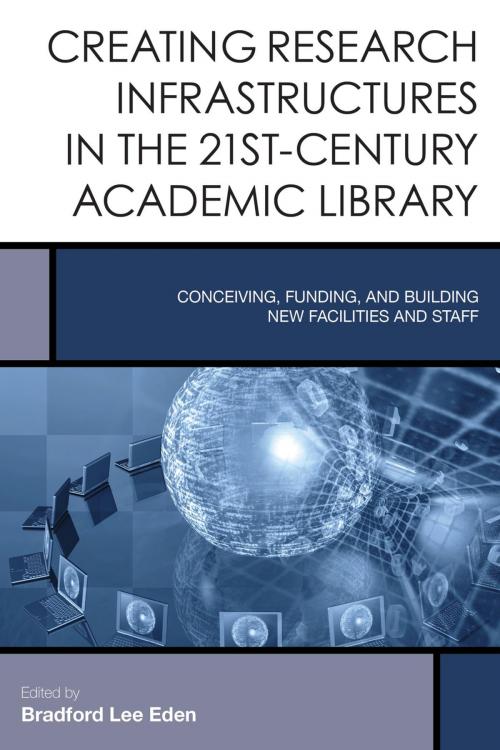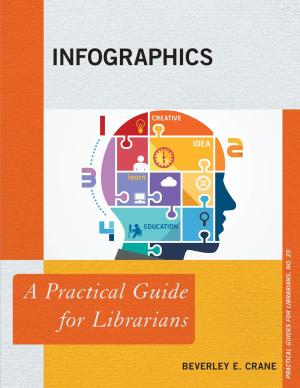Creating Research Infrastructures in the 21st-Century Academic Library
Conceiving, Funding, and Building New Facilities and Staff
Nonfiction, Reference & Language, Language Arts, Library & Information Services| Author: | ISBN: | 9781442252424 | |
| Publisher: | Rowman & Littlefield Publishers | Publication: | August 13, 2015 |
| Imprint: | Rowman & Littlefield Publishers | Language: | English |
| Author: | |
| ISBN: | 9781442252424 |
| Publisher: | Rowman & Littlefield Publishers |
| Publication: | August 13, 2015 |
| Imprint: | Rowman & Littlefield Publishers |
| Language: | English |
Creating Research Infrastructures in the 21st-Century Academic Library: Conceiving, Funding, and Building New Facilities and Staff focuses on research infrastructures, bringing together such topics as research and development in libraries, dataset management, e-science, grants and grant writing, digital scholarship, data management, library as publisher, web archiving, and the research lifecycle. Individual chapters deal with the formation of Research & Development teams; emerging scholarly forms and new collaborative approaches to knowledge creation, dissemination, and preservation; managing small databases requiring the same level of support as large databases: metadata, digital preservation and curation, and technical support. Motivation for such services is provided in a chapter that considers how assessment and data now drive decisions and new services in higher education in general and academic libraries in particular and how statistical data can help to tell stories, make decisions, and move in new directions. Conceptualization of the research process also receives attention through the presentation of a research lifecycle in the university environment with the library as an integral partner and leader. Also, a topic that is increasingly important: the library as publisher, with new institutional repositories tied to journal creation, curation, and management is examined with a discussion of the workflow and expertise necessary for the library to be successful and responsive to the research needs of its institution, and become a leader in providing publishing services to its faculty. A related topic, Web archiving in libraries is explored in a chapter that includes discussions on the process of establishing buy-in and legal permission, the policies and procedures, and the technology necessary for its success.
All of these efforts require funding and chapters are included that address this need: finding funding outside of the university for support of the library is now a necessary and vital part of academic libraries: guidelines and steps for how to write a grant and be successful at obtaining outside funds. A second chapter deals with the problem of developing a grant-seeking culture in the library, what some of the barriers are to the grant-writing process and how to create a reward system for a grant-writing culture.
The volume concludes with two case studies related to implementing research data management services at two liberal arts colleges. They demonstrate that the integration of data management services for undergraduate and faculty research in liberal arts colleges is just as important as it is for the large research universities, and that new service models should be incorporated so that all librarians and library staff participate in this integration in their duties and responsibilities.
It is hoped that this volume, and the series in general, will be a valuable and exciting addition to the discussions and planning surrounding the future directions, services, and careers in the twenty-first-century academic library.
Creating Research Infrastructures in the 21st-Century Academic Library: Conceiving, Funding, and Building New Facilities and Staff focuses on research infrastructures, bringing together such topics as research and development in libraries, dataset management, e-science, grants and grant writing, digital scholarship, data management, library as publisher, web archiving, and the research lifecycle. Individual chapters deal with the formation of Research & Development teams; emerging scholarly forms and new collaborative approaches to knowledge creation, dissemination, and preservation; managing small databases requiring the same level of support as large databases: metadata, digital preservation and curation, and technical support. Motivation for such services is provided in a chapter that considers how assessment and data now drive decisions and new services in higher education in general and academic libraries in particular and how statistical data can help to tell stories, make decisions, and move in new directions. Conceptualization of the research process also receives attention through the presentation of a research lifecycle in the university environment with the library as an integral partner and leader. Also, a topic that is increasingly important: the library as publisher, with new institutional repositories tied to journal creation, curation, and management is examined with a discussion of the workflow and expertise necessary for the library to be successful and responsive to the research needs of its institution, and become a leader in providing publishing services to its faculty. A related topic, Web archiving in libraries is explored in a chapter that includes discussions on the process of establishing buy-in and legal permission, the policies and procedures, and the technology necessary for its success.
All of these efforts require funding and chapters are included that address this need: finding funding outside of the university for support of the library is now a necessary and vital part of academic libraries: guidelines and steps for how to write a grant and be successful at obtaining outside funds. A second chapter deals with the problem of developing a grant-seeking culture in the library, what some of the barriers are to the grant-writing process and how to create a reward system for a grant-writing culture.
The volume concludes with two case studies related to implementing research data management services at two liberal arts colleges. They demonstrate that the integration of data management services for undergraduate and faculty research in liberal arts colleges is just as important as it is for the large research universities, and that new service models should be incorporated so that all librarians and library staff participate in this integration in their duties and responsibilities.
It is hoped that this volume, and the series in general, will be a valuable and exciting addition to the discussions and planning surrounding the future directions, services, and careers in the twenty-first-century academic library.















